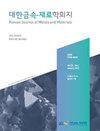材料选择:利用数据挖掘的聚类分析和关联规则分析进行材料感知数据分析
IF 1.4
4区 材料科学
Q4 MATERIALS SCIENCE, MULTIDISCIPLINARY
引用次数: 0
摘要
为了选择适合产品的材料,人们对材料感知(即消费者对材料的感觉)进行了研究。材料感知数据是通过对两极形容词对的数字逻辑调查获得的。通过数据挖掘的无监督学习,对材料感知数据进行了分析。在进行数据分析之前,为了提高数据的可靠性,使用聚类分析、相关性分析和卡方检验测试了不同调查之间数据的同质性。在检验了不同调查之间数据的同质性后,对数据进行了合并。合并后的物质感知数据使用相对频率、层次聚类和关联规则进行分析。从调查参与者的选择中获得的相对频率用于确定对每种材料的普遍看法,并作为其他分析的基本数据。在分层聚类分析中,利用聚类内部的距离和聚类之间的距离来确定层次。通过关联规则分析,可以了解消费者对材料的同时感知,因此在根据消费者感知选择材料时,不仅可以考虑材料的个体特征,还可以考虑关系特征。分析后的特征被设计成材料感知图,该材料感知图将成为帮助产品设计师在选择材料时更好地做出符合消费者感知和体验的选择的有力工具。本文章由计算机程序翻译,如有差异,请以英文原文为准。
Material Selection: Material Perception Data Analysis Using Clustering Analysis and Association Rule Analysis of Data Mining
To select materials suitable for products, material perception, which is the feeling consumers have about materials, has been studied. Material perception data were obtained through surveys using digital logic for bipolar adjective pairs. The material perception data were analyzed through unsupervised learning of data mining. Prior to data analysis, to increase the reliability of the data, the homogeneity of the data between surveys was tested using clustering analysis, correlation analysis and chi-squared test. After checking the homogeneity of the data between surveys, the data were merged. The merged material perception data were analyzed using relative frequencies, hierarchical clustering, and association rules. The relative frequencies obtained from survey participants' selections were used to determine the prevailing perceptions of each material and as basic data for other analyses. In the hierarchical clustering analysis, hierarchy was identified using distances within clusters and distances between clusters. Through association rule analysis, the consumer's simultaneous perceptions of the material can be known, so not only the individual characteristics of the material but also the relational characteristics can be considered when selecting materials based on consumer's perception. The analyzed characteristics were designed into a material perception map, and this material perception map will be a powerful tool to help product designers make better choices that match consumers' perception and experience when selecting materials.
求助全文
通过发布文献求助,成功后即可免费获取论文全文。
去求助
来源期刊

Korean Journal of Metals and Materials
MATERIALS SCIENCE, MULTIDISCIPLINARY-METALLURGY & METALLURGICAL ENGINEERING
CiteScore
1.80
自引率
58.30%
发文量
100
审稿时长
4-8 weeks
期刊介绍:
The Korean Journal of Metals and Materials is a representative Korean-language journal of the Korean Institute of Metals and Materials (KIM); it publishes domestic and foreign academic papers related to metals and materials, in abroad range of fields from metals and materials to nano-materials, biomaterials, functional materials, energy materials, and new materials, and its official ISO designation is Korean J. Met. Mater.
 求助内容:
求助内容: 应助结果提醒方式:
应助结果提醒方式:


